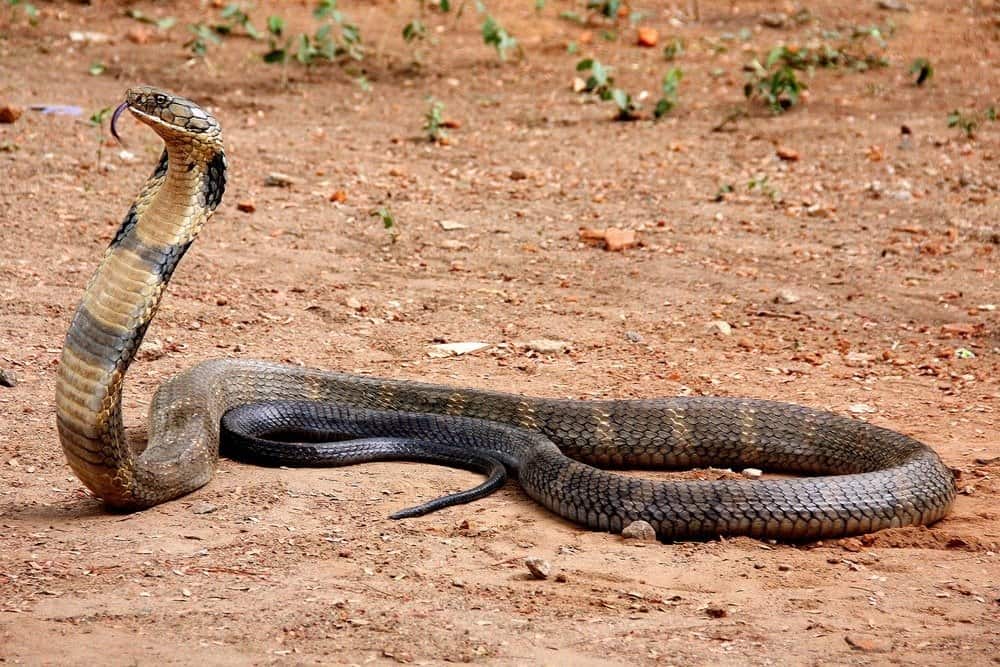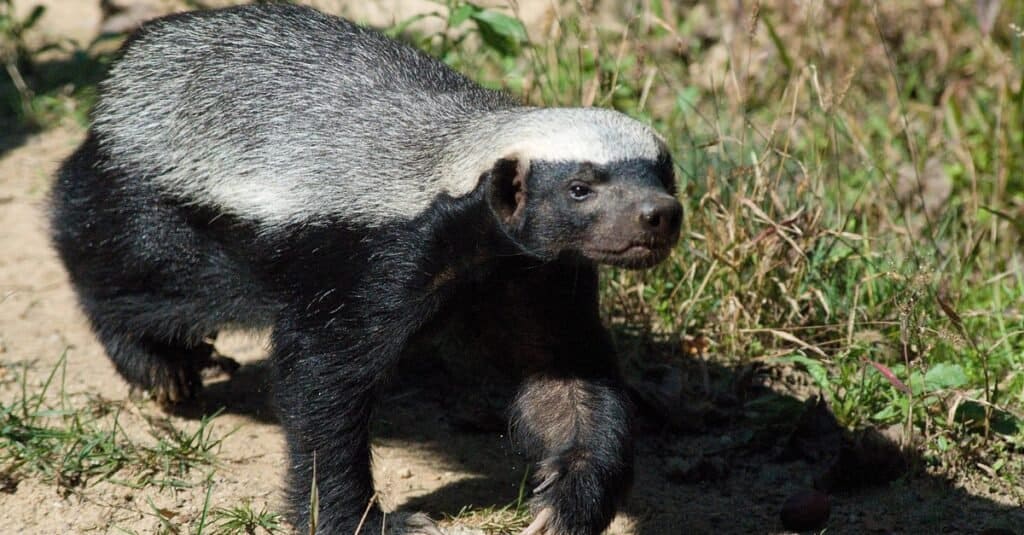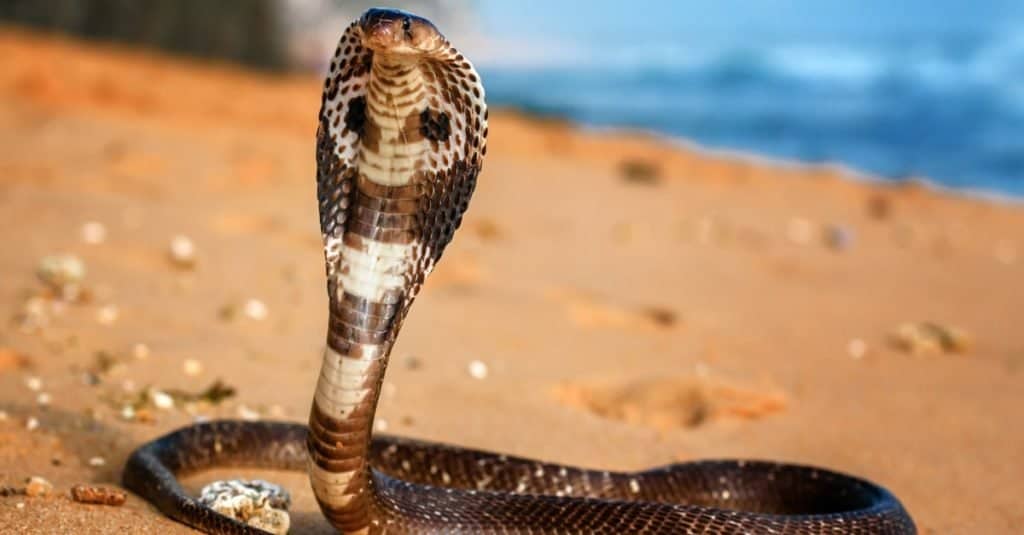Honey badgers (Mellivora capensis), also known as ratels, are usually regarded to be among the toughest animals on the planet. They are famous for their strength, ferocity, and toughness; they belong to the Mustelidae family. There are 11 sub-species of honey badgers widely scattered in Africa, India, and Southwest Asia. These mammals can adapt to a variety of conditions, from warm rainforests to cold mountains.
The king cobra (Ophiophagus hannah), on the other hand, is the longest venomous snake in the world, belonging to the Elapidae family. King cobras are found in Asia and, depending on the region, they come in different colors.
So, what happens if these two animals fight? This article will examine a honey badger and a king cobra and show you which of these creatures is likely to survive if a fight ensues.
Comparing a Honey Badger and a King Cobra

| Honey Badger | King Cobra | |
|---|---|---|
| Size | Weight: 13lbs to 35lbs (6-16kg) Length: 1.5ft to 2.5ft Height: 9inches to 11inches (23cm to 28cm) | Weight: They typically weigh around 13lbs (6kg). Length: 10ft to 12ft (3m- 3.6m) Height: 18.5ft long (5.6m). |
| Speed | 25 to 30km/h (16- 19mph) | Like the sidewinder, King Cobra moves up to 18mph. |
| Unique qualities | -They have poor eyesight like most Mustelids. -They are ferocious, tough, and thick-skinned. -They are great excavators. -Good sense of smell | -Possession of 11 large scales on the crown of its head. -Good sense of smell using their forked tongue. -Outstanding intelligence -Excellent eyesight |
| Defenses | -They have thick skin that can withstand bee stings and porcupine quills. -Thick fur and loose skin enables them to twist around when captured by a predator. -Ability to resist snake venom. | -Display threats by hissing loudly. -They can camouflage, which helps them blend in with the environment. -Upreared defense posture. |
| Offensive Capabilities | -Sharp claws and teeth -Powerful bites | -Powerful bite force. -Bite several times and secrete a venom. -It can raise a third of its body off the ground to attack when confronted. |
| Predatory Behaviour | -They have strong, sharp teeth and jaws powerful enough to crack open a small tortoise. -Prey on small mammals. -They can dig their prey out from burrows. | -Ambush predators |
The Key Differences Between a Honey Badger and a King Cobra
The major differences between a honey badger and a king cobra lie in their size, morphology, behavior, and method of attack.
Honey badgers are tough, extremely aggressive, and solitary creatures. They have short and sturdy legs with very strong claws adapted for catching prey and digging. They measure around 9 to 11 inches in shoulder height and weigh about 13 to 35 pounds. On the other hand, king cobras are creeping reptiles measuring about 18.5 feet in length and weighing around 13 pounds, and they are capable of secreting deadly venom strong enough to kill an elephant in just a single bite.
Understanding these differences between these animals gives us a better overview of all the unique qualities and advantages they have over one another. However, to determine who would win this fight, we need to analyze other factors too. Let’s take a look at the different factors of the battle between a honey badger and a king cobra. Let’s start!
Honey Badger vs King Cobra: Size

A fully grown honey badger can measure up to three feet long.
©Meoita/Shutterstock.com
Fully grown honey badgers can measure up to 3 feet long and weigh around 35 pounds, making them larger than king cobras. King cobras, however, are longer and may grow up to 18.5 feet long. They weigh about 13 pounds, and their deadly fangs are nearly 0.5 inches long. The largest known king cobra captured in Thailand was estimated to be 18 feet long.
Honey Badger vs King Cobra: Speed

The king cobra can move at 17.6 feet per second, reaching 12 miles per hour.
©Jolly Therattil/Shutterstock.com
Both the honey badger and king cobra have amazing speed and agility. Honey badgers can run or gallop at 16 to 19 mph over short periods. They can climb trees and are regarded to be excellent swimmers. King cobras can move at 17.6 feet per second, reaching 12 miles per hour.
Honey Badger vs King Cobra: Unique Qualities
Although they are known to be aggressive, king cobras shy away from humans. These snakes are one of the deadliest snakes in the world. When they bite, they secrete neurotoxins into their prey that are potent enough to kill even an elephant in a single strike. King cobras possess excellent eyesight, outer intelligence, and a good sense of smell, using their forked tongues to locate prey almost 328 feet away.
On the other hand, honey badgers are considered outstanding digging machines. Their remarkable long forelimbs enable them to tunnel through the soil, digging burrows used to catch prey, protect themselves, and sleep. Known for their aggressive behavior, honey badgers are fearless and can skillfully escape predators. According to the Journal of Zoology in the Middle East, they also have good eyesight and a good sense of smell for detecting prey.
Honey Badger vs King Cobra: Defenses

The honey badger has a very thick fur and a layer of loose skin surrounding its muscular neck.
©Pavel Kovaricek/Shutterstock.com
The honey badger has a very thick fur and a layer of loose skin surrounding its muscular neck, which protects and allows it to twist around when captured by a predator. It defends itself by squirting a foul-smelling liquid from two anal glands hidden near the base of its tail. Moreover, the honey badger has an adaptation for resisting bee stings and snake venom.
Like the rattlesnake, the king cobra has camouflage, which helps it blend in effortlessly with its surroundings. This snake has frightening threat displays, including hissing loudly, spreading its neck flap, and adopting an upright defense posture.
Overall, honey badgers have far better defenses than king cobras.
Honey Badger vs King Cobra: Combat Skills

The king cobra can raise a third of its body mass off the ground and rush forward to attack when threatened.
©Vova Shevchuk/Shutterstock.com
The king cobra kills more than five people each year within its range. It can raise a third of its body mass off the ground and rush forward to attack when threatened. This snake bites several times with a 100% envenomation rate, releasing its venom into any animal it comes across.
Meanwhile, honey badgers have strong claws of about 1.5 inches long and jaws powerful enough to break bones and crack open the shell of small tortoises. They are good hunters and foragers and have been seen chasing young lions away from their kill and stealing their food.
Who Would Win in a Fight Between a Honey Badger and a King Cobra?

The honey badger would kill the king cobra in a fight.
©Erwin Niemand/Shutterstock.com
The honey badger would kill the king cobra in a fight. The king cobra may be a very deadly snake and appear to be threatening, but honey badgers are fearless. They are both aggressive. However, the honey badger is built for battle and has a resistance to snake venom.
Unlike pythons, king cobras don’t constrict that much and are probably unable to subdue honey badgers. They usually rely on their fatal venom to kill other animals. However, they have small fangs, and it may take more than one bite for their venom to find its way into the tough, thick skin of the honey badger. Therefore, the honey badger would likely kill the snake if no venom is injected. If the badger gets bitten, it will probably kill the snake and die after that or lie down, allowing the venom’s effect to wear off before finishing its meal.
This is not so surprising given that the honey badger is one of the few mammals that often prey on venomous snakes for food.
The photo featured at the top of this post is © Erwin Niemand/Shutterstock.com
Thank you for reading! Have some feedback for us? Contact the AZ Animals editorial team.







